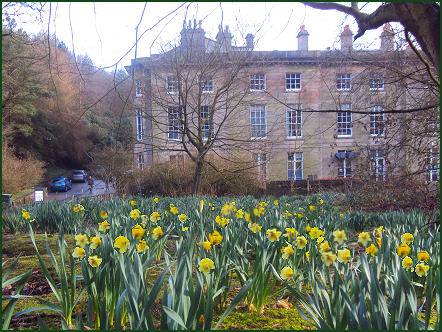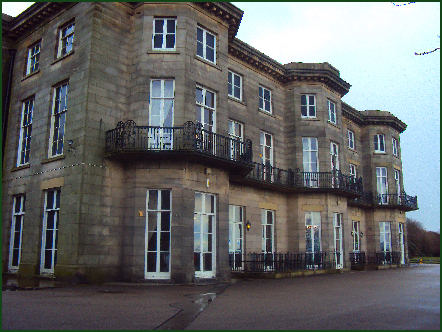Haigh Hall
OS Grid ref:- SD 597085
 Previously the home of the Earl of Crawford and Balcarres, Haigh Hall (pronounced "Hay") is situated near Wigan.
Previously the home of the Earl of Crawford and Balcarres, Haigh Hall (pronounced "Hay") is situated near Wigan.
The hall was built between 1827 and 1840, mainly with local materials quarried from nearby Parbold, by James Lindsay, 7th Earl of Balcarres. The hall replaced an ancient manor house and was his family's home until 1947 when it was sold to Wigan Council.
The three-storey building is square in plan and is built around a central light well. The south east entrance facade is symmetrical and has 11 bays of which four project. The facade has a top cornice and parapet. The interior is richly decorated, particularly the ceilings. The entrance hall has a coffered ceiling and palmette frieze and two black marble fireplaces. The stair hall is sail vaulted with a central light and the staircase has a cast iron balustrade.The first floor library has a decorated ceiling.
The Lindsay family's library, the Bibliotheca Lindesiana, is housed on the first floor. The origins of the library possibly date back to the late sixteenth century at Balcarres in Fife. The collection, which includes a Gutenberg Bible, was expanded by Alexander Lindsay, 8th Earl of Balcarres (1812–1880) . His son and heir, James Lindsay, 26th Earl of Crawford, along with his father, enlarged the library to make it one of the largest private collections in Britain.
 A manor house occupied the site in the Middle Ages. The name Haigh derives from the Anglo Saxon word Haga meaning an enclosure or a secure area to house livestock.
The origins of Haigh and the owner of the original manor is not known. The earliest recorded date of title is 1295 when William de Bradshaigh married Mabel le Norreys, the natural heir to the estates of Haigh and Blackrod.
A manor house occupied the site in the Middle Ages. The name Haigh derives from the Anglo Saxon word Haga meaning an enclosure or a secure area to house livestock.
The origins of Haigh and the owner of the original manor is not known. The earliest recorded date of title is 1295 when William de Bradshaigh married Mabel le Norreys, the natural heir to the estates of Haigh and Blackrod.
According to one local legend, in 1324, William de Bradshaigh returned from the wars in Scotland, killed his wife's new husband, and made her walk barefoot and dressed in sackcloth to their home at Haigh Hall once a week for the remainder of her life. The account was made into a novel by Sir Walter Scott, and the event is still marked by Mab's Cross in Wigan Lane. In reality Sir William Bradshaigh’s absence from Haigh was due to his banishment by King Edward II for taking part in a rebellion against the Earl of Lancaster.
The Bradshaigh family became extinct in the male line in 1787. The property then passed to the Lindsay family through the marriage of Alexander Lindsay, 6th Earl of Balcarres to Elizabeth Dalrymple, only child of Charles Dalrymple on June 1st, 1780,Elizabeth Dalyrmple's mother was the grandaughter of Roger Bradshaigh of Haigh.
The hall is set in 250 acres of wood and parkland superb views across the Douglas Valley to the Welsh Hills, Haigh Country Park boasts a range of facilities, which include include a play area, mini golf, craft gallery, information centre, gift shop, cafeteria and a miniature railway, which first opened in July 1986, takes the visitor on an interesting and scenic ride around the woodlands past the walled gardens and Swan Pond.
Directions
Haigh Hall is within easy reach of both the M6 (Junction 27) and the M61 (Junction 6). If approaching from the M6, take the A49 towards Standish, then the B5239 to Haigh. Look out for the B5239 and Aspull, then Haigh, when leaving the M61. Alternatively, Haigh Country Park can easily be found close to the two main A roads, the A6 and the A49. The B roads to look for are the B5238 and the B5239.
Satellite Navigation Co-ordinates
Lat = 53 34 18.2n Lon = 2 36 34.0w
